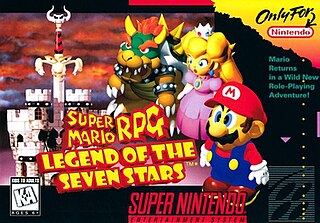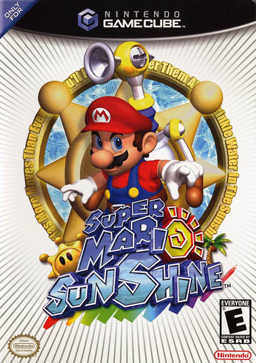
Princess Peach is a character in Nintendo's Mario franchise. She was created by Shigeru Miyamoto and introduced in the 1985 original Super Mario Bros. game as Princess Toadstool. She is the princess regnant and head of state of the Mushroom Kingdom, where she resides in her castle along with Toads. Since her debut, she has appeared in the majority of Mario video games as the main female character and the romantic interest of Mario. She has been voiced by Samantha Kelly since 2007.

Super Mario RPG: Legend of the Seven Stars is a 1996 role-playing video game developed by Square and published by Nintendo for the Super Nintendo Entertainment System (SNES). It was the final Mario game for the SNES. The game was directed by Chihiro Fujioka and Yoshihiko Maekawa, produced by Shigeru Miyamoto, and scored by Yoko Shimomura.

Super Mario Bros. 2 is a platform game developed and published by Nintendo for the Nintendo Entertainment System. It was first released in North America in September 1988 and in the PAL region in 1989.

Super Mario Sunshine is a 2002 platform game developed and published by Nintendo for the GameCube. It is the second 3D game in the Super Mario series, following Super Mario 64 (1996). The game was directed by Yoshiaki Koizumi and Kenta Usui, produced by series creators Shigeru Miyamoto and Takashi Tezuka, written by Makoto Wada, and scored by Koji Kondo and Shinobu Tanaka.

Kenneth "Kenny" McCormick is a fictional character and one of the four main protagonists in the adult animated sitcom South Park, alongside Stan Marsh, Kyle Broflovski, and Eric Cartman. His often muffled and incomprehensible speech—the result of his parka hood covering his mouth—is provided by co-creator Matt Stone. After early appearances in The Spirit of Christmas shorts in 1992 and 1995, Kenny appeared in South Park television episodes beginning August 13, 1997, as well as the 1999 feature film South Park: Bigger, Longer & Uncut, where his uncovered face and voice were first revealed.

Mario Golf: Toadstool Tour, known in Japan as Mario Golf: Family Tour, is a 2003 sports game developed by Camelot Software Planning and published by Nintendo for the GameCube. It is the sequel to the 1999 Nintendo 64 title Mario Golf, and is the third game in the Mario Golf series. It was released in North America on July 28, 2003, in Japan on September 5, 2003, and in PAL regions in 2004.
Studio 4°C Co., Ltd. is a Japanese animation studio founded by Eiko Tanaka and Kōji Morimoto in 1986. The name comes from the temperature at which water is most dense.

The Nintendo Comics System was a series of comic books published by Valiant Comics in 1990 and 1991. It was part of a licensing deal with Nintendo, featuring characters from their video games and the cartoons based on them.

The Legend of Zelda: Twilight Princess is a 2006 action-adventure game developed and published by Nintendo for the GameCube and Wii. Originally planned for release exclusively on the GameCube in November 2005, Twilight Princess was delayed by Nintendo to allow its developers to refine the game, add more content, and port it to the Wii. The Wii version was a launch game in North America in November 2006, and in Japan, Europe, and Australia the following month. The GameCube version was released in December 2006 as the final first-party game for the console.
Fascination may refer to:

The Pine Ridge is an escarpment between the Niobrara River and the White River in far northwestern Nebraska. The high tableland between the rivers has been eroded into a region of forested buttes, ridges and canyons.

Super Princess Peach is a 2005 platform game developed by Tose and published by Nintendo for the Nintendo DS. It was released in Japan in October 2005 and worldwide the following year. Super Princess Peach is the first game to feature Princess Peach as the main protagonist on a dedicated video game console and the second overall after Princess Toadstool's Castle Run released in 1990 on the Nelsonic Game Watch.

Super Mario Adventures is an anthology of comics that ran in Nintendo Power throughout 1992, featuring the characters from Nintendo's Mario series and based loosely on Super Mario World. In 1993, the series was also serialized in CoroCoro Comic in Japanese, under the title Mario's Big Adventure. Charlie Nozawa, the artist who created the comics, is also known by the pen name Tamakichi Sakura. Kentaro Takekuma was responsible for the story, which follows Mario and Luigi as they attempt to rescue Princess Toadstool after she is kidnapped by Bowser with intent to marry her.

The Super Mario Bros. Super Show! is an American live-action/animated television series that aired from September 4 to December 1, 1989, in syndication. The series is based on the video games Super Mario Bros. and Super Mario Bros. 2 by Nintendo, and is the first of three television series to be based upon the Mario video game series. The animation was provided by South Korean company Sei Young Animation.

Hotel Mario is a puzzle video game developed by Fantasy Factory and published by Philips Interactive Media on the CD-i format on April 5, 1994. The player controls Mario, who must find Princess Toadstool by going through seven hotels in the Mushroom Kingdom; each hotel is divided into stages, and the objective is to close all of the doors on each stage. Each hotel ends in a boss fight with one of Bowser's Koopalings, culminating in a battle with Bowser.

Disney Princess, also called the Princess Line, is a media franchise and toy line owned by the Walt Disney Company. Created by Disney Consumer Products chairman Andy Mooney, the franchise features a lineup of female protagonists who have appeared in various Disney franchises.

The Adventures of Super Mario Bros. 3 is an American animated television series. It premiered on September 8, 1990, on NBC. It is the second animated series to be based on Nintendo's Mario video game series and is loosely based on the video game Super Mario Bros. 3. The animation was provided by Sei Young Animation.
Nelsonic Industries is an American electronics manufacturing and development company that operated from Long Island City, Queens, New York City in the early 1980s and throughout the 1990s when it was acquired by the watch-manufacturer, M.Z. Berger. Nelsonic produced numerous toy-themed wristwatches, often targeting younger audiences with likenesses of characters from popular franchises such as Barbie, the Ghostbusters, and Mario. Nelsonic became notable during the early mid-1980s for being the first electronics company in the United States to produce game-watches. For a period subsequent to its purchase by M.Z. Berger, Nelsonic operated as a subsidiary division of its parent company and game-watches were produced that bore the Nelsonic mark. This practice ended as M.Z. Berger shifted focus to more traditional and higher-end timepieces. Today the original Nelsonic Game Watch line has entered the secondary market and individual Game Watches have become highly sought-after collectibles that often fetch high prices on eBay and other online auction websites.













